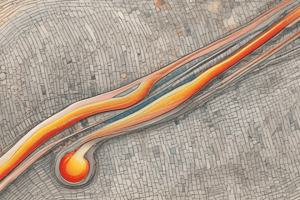Podcast
Questions and Answers
What is the primary mechanism of energy transfer in conduction?
What is the primary mechanism of energy transfer in conduction?
- Vibrating particles transferring energy to neighboring particles (correct)
- Heat rising due to density differences
- Movement of energetic particles
- Energy flow through radiation
Convection can occur in solids.
Convection can occur in solids.
False (B)
What does thermal conductivity measure?
What does thermal conductivity measure?
How quickly energy is transferred through a material
In convection, warmer regions of a fluid are __________ than cooler regions.
In convection, warmer regions of a fluid are __________ than cooler regions.
Match the following terms with their correct descriptions:
Match the following terms with their correct descriptions:
What does the conservation of energy principle state?
What does the conservation of energy principle state?
In a closed system, energy can leave the system.
In a closed system, energy can leave the system.
What unit is power measured in?
What unit is power measured in?
Power is defined as the rate of ______ transfer.
Power is defined as the rate of ______ transfer.
If Motor A lifts an object in 50 seconds and Motor B in 300 seconds, which motor is more powerful?
If Motor A lifts an object in 50 seconds and Motor B in 300 seconds, which motor is more powerful?
Using the formula Power = Work done / Time, what is the power of Motor A if it lifts 8000 J of work in 50 s?
Using the formula Power = Work done / Time, what is the power of Motor A if it lifts 8000 J of work in 50 s?
Match the type of energy to its description:
Match the type of energy to its description:
All energy transferred in a system is useful energy.
All energy transferred in a system is useful energy.
What does the efficiency of a device measure?
What does the efficiency of a device measure?
What is the main purpose of using lubricants in a system?
What is the main purpose of using lubricants in a system?
Electric heaters are generally considered 100% efficient.
Electric heaters are generally considered 100% efficient.
Thicker walls with higher thermal conductivity will slow down energy transfer.
Thicker walls with higher thermal conductivity will slow down energy transfer.
What is the formula for calculating efficiency using energy transfer?
What is the formula for calculating efficiency using energy transfer?
The efficiency of a device can be improved by __________ its surfaces.
The efficiency of a device can be improved by __________ its surfaces.
What is the effect of cavity wall insulation on energy transfer?
What is the effect of cavity wall insulation on energy transfer?
Match the following devices with their described efficiencies:
Match the following devices with their described efficiencies:
___ energy is converted to thermal energy due to frictional forces.
___ energy is converted to thermal energy due to frictional forces.
Match the following insulation methods with their benefits:
Match the following insulation methods with their benefits:
Which of the following is NOT a method to improve thermal insulation?
Which of the following is NOT a method to improve thermal insulation?
Materials like bubble wrap and cotton wool are poor thermal insulators.
Materials like bubble wrap and cotton wool are poor thermal insulators.
How does the thickness of an insulation layer affect temperature change?
How does the thickness of an insulation layer affect temperature change?
Which of the following is a disadvantage of wind power?
Which of the following is a disadvantage of wind power?
Solar cells can generate electricity during the night.
Solar cells can generate electricity during the night.
What is the primary energy source for geothermal power?
What is the primary energy source for geothermal power?
Solar power is considered __________ after the initial investment.
Solar power is considered __________ after the initial investment.
Match the energy source to its corresponding pro:
Match the energy source to its corresponding pro:
Which of the following is a non-renewable energy resource?
Which of the following is a non-renewable energy resource?
Renewable energy resources will eventually be depleted.
Renewable energy resources will eventually be depleted.
Name one characteristic of non-renewable energy resources.
Name one characteristic of non-renewable energy resources.
______ energy resources can be used for heating buildings and include geothermal heat pumps.
______ energy resources can be used for heating buildings and include geothermal heat pumps.
Match the following energy resources with their type:
Match the following energy resources with their type:
What is the most common heating fuel in the UK?
What is the most common heating fuel in the UK?
Biofuels are considered renewable energy resources.
Biofuels are considered renewable energy resources.
List two uses of energy resources in transport.
List two uses of energy resources in transport.
What is the specific heat capacity of water?
What is the specific heat capacity of water?
Materials that cool down rapidly have a low specific heat capacity.
Materials that cool down rapidly have a low specific heat capacity.
What is the equation used to calculate the change in thermal energy?
What is the equation used to calculate the change in thermal energy?
To warm 1 kg of water by 1°C, _____ J of energy is needed.
To warm 1 kg of water by 1°C, _____ J of energy is needed.
Match the material with its specific heat capacity needed to heat 1 kg by 1°C:
Match the material with its specific heat capacity needed to heat 1 kg by 1°C:
How much energy is required to heat 5 kg of water to increase its temperature by 1°C?
How much energy is required to heat 5 kg of water to increase its temperature by 1°C?
The gradient of the straight line in a graph of energy transferred vs. temperature represents the specific heat capacity.
The gradient of the straight line in a graph of energy transferred vs. temperature represents the specific heat capacity.
How can you determine the specific heat capacity of a solid material experimentally?
How can you determine the specific heat capacity of a solid material experimentally?
Flashcards
Definition of Conduction
Definition of Conduction
Energy transfer between particles by vibration.
What is Thermal Conductivity?
What is Thermal Conductivity?
Material's ability to transfer heat quickly.
How does Convection work?
How does Convection work?
Heating causes particles to move and rise, creating a current.
Convection Happens in?
Convection Happens in?
Signup and view all the flashcards
Convection Example
Convection Example
Signup and view all the flashcards
Specific Heat Capacity
Specific Heat Capacity
Signup and view all the flashcards
Conservation of Energy Principle
Conservation of Energy Principle
Signup and view all the flashcards
Energy Transfer
Energy Transfer
Signup and view all the flashcards
Equation for specific heat capacity
Equation for specific heat capacity
Signup and view all the flashcards
Investigating specific heat capacity of solids
Investigating specific heat capacity of solids
Signup and view all the flashcards
Dissipated Energy
Dissipated Energy
Signup and view all the flashcards
Power
Power
Signup and view all the flashcards
Investigating specific heat capacity of liquids
Investigating specific heat capacity of liquids
Signup and view all the flashcards
Unit of Power
Unit of Power
Signup and view all the flashcards
Calculating energy transferred
Calculating energy transferred
Signup and view all the flashcards
Powerful Machine
Powerful Machine
Signup and view all the flashcards
Graph of energy vs. temperature
Graph of energy vs. temperature
Signup and view all the flashcards
Power Calculation
Power Calculation
Signup and view all the flashcards
Specific heat capacity of water
Specific heat capacity of water
Signup and view all the flashcards
Closed System (Energy)
Closed System (Energy)
Signup and view all the flashcards
Units of specific heat capacity
Units of specific heat capacity
Signup and view all the flashcards
Efficiency
Efficiency
Signup and view all the flashcards
Wasted Energy
Wasted Energy
Signup and view all the flashcards
Calculating Efficiency
Calculating Efficiency
Signup and view all the flashcards
Electric Heater Efficiency
Electric Heater Efficiency
Signup and view all the flashcards
Why is 100% Efficiency Impossible?
Why is 100% Efficiency Impossible?
Signup and view all the flashcards
Lubrication's Role
Lubrication's Role
Signup and view all the flashcards
Friction's Effect
Friction's Effect
Signup and view all the flashcards
Insulation's Goal
Insulation's Goal
Signup and view all the flashcards
Cavity Wall Insulation
Cavity Wall Insulation
Signup and view all the flashcards
Loft Insulation
Loft Insulation
Signup and view all the flashcards
Double-Glazed Windows
Double-Glazed Windows
Signup and view all the flashcards
Draught Excluders' Role
Draught Excluders' Role
Signup and view all the flashcards
Investigating Insulation
Investigating Insulation
Signup and view all the flashcards
Wind Power
Wind Power
Signup and view all the flashcards
Solar Cell Energy
Solar Cell Energy
Signup and view all the flashcards
Geothermal Energy
Geothermal Energy
Signup and view all the flashcards
Pros of Renewable Energy
Pros of Renewable Energy
Signup and view all the flashcards
Cons of Renewable Energy
Cons of Renewable Energy
Signup and view all the flashcards
Non-renewable energy
Non-renewable energy
Signup and view all the flashcards
Fossil fuels
Fossil fuels
Signup and view all the flashcards
Renewable energy
Renewable energy
Signup and view all the flashcards
Solar energy
Solar energy
Signup and view all the flashcards
Bio-fuel
Bio-fuel
Signup and view all the flashcards
Energy in Transportation
Energy in Transportation
Signup and view all the flashcards
Energy in Heating
Energy in Heating
Signup and view all the flashcards
Distinguishing Renewable and Non-renewable
Distinguishing Renewable and Non-renewable
Signup and view all the flashcards




